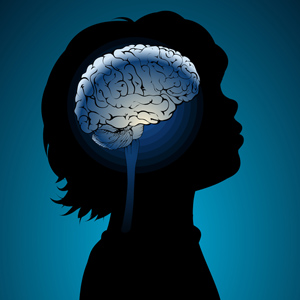Cardiovascular Problems in Bipolar Disorder May Begin in Adolescence
Adults with bipolar disorder have higher rates of cardiovascular disease and premature death from cardiovascular illness than the general population. At the 2012 meeting of the American Academy of Child and Adolescent Psychiatry, Benjamin Goldstein presented a poster in which he showed that youth with bipolar disorder may also have abnormal cardiovascular function.
When a tourniquet is applied, blood vessels normally expand to make up for the period of oxygen deprivation. This does not happen as readily in patients with mood disorders. This lack of flexibility and compensatory response could be one of the reasons for increased cardiovascular difficulties in those with mood disorders.
In Goldstein’s study, noninvasive ultrasound imaging was used to measure the thickness of the walls of the carotid artery and flow mediated dilation of the artery in adolescents with bipolar disorder and those without the illness. The data was collected by a certified ultrasound technologist who remained blind to the patients’ diagnostic and symptom status.
Goldstein found highly abnormal results in 14 adolescents aged 14 to 19 with bipolar disorder compared to controls. He concluded that reducing cardiovascular risk in bipolar disorder is a pressing clinical and public health challenge and that treating these patients while they are adolescents may offer considerable advantages both for prevention and for understanding the progression of cardiovascular problems in patients with bipolar disorder.
Brain Imaging Finds Abnormalities that Appear Over the Course of Childhood-Onset Bipolar Illness
 There is considerable evidence that children with bipolar disorder have smaller amygdalas, and the amygdala also appears to be hyper-reactive when these children perform facial emotion recognition tasks. A symposium on longitudinal imaging studies in pediatric bipolar disorder was held at the 2012 meeting of the American Academy of Child and Adolescent Psychiatry to shed light on other brain abnormalities in these children.
There is considerable evidence that children with bipolar disorder have smaller amygdalas, and the amygdala also appears to be hyper-reactive when these children perform facial emotion recognition tasks. A symposium on longitudinal imaging studies in pediatric bipolar disorder was held at the 2012 meeting of the American Academy of Child and Adolescent Psychiatry to shed light on other brain abnormalities in these children.
Researcher Nancy Aldeman reported that there is some evidence children with bipolar disorder have decreased gray matter volume in parts of the brain including the subgenual cingulate gyrus, the orbital frontal cortex, and the superior temporal gyrus, as well as the left dorsolateral prefrontal cortex and amygdala. At the same time there is evidence of increased size of the basal ganglia. These abnormalities do not appear to precede the onset of the illness.
Some changes occur over the course of the illness. The basal ganglia seem to increase in volume in patients with bipolar disorder, but decrease in volume in those with severe mood dysregulation and comorbid ADHD. Moreover, parietal cortex and precuneus cortex volumes appeared to increase in children with bipolar disorder while decreasing or staying the same in normal volunteer controls.
A meta-analysis of brain imaging studies indicated that in general, the size of the amygdala appears to increase from childhood to adulthood in bipolar patients, starting out smaller than that of similarly-aged normal volunteers, but becoming larger than that of adult normal volunteers as the patients age into adulthood.
Lithium treatment increases gray matter volume in a variety of cortical areas and in the hippocampus in multiple studies. In contrast, treatment with valproate for 6 weeks appears to decrease hippocampal volume.
Long-term Course of Bipolar Illness is Most Difficult
While the 4 major childhood-onset psychiatric illnesses we discussed this week (bipolar, unipolar, ADHD, and anxiety disorders) show long term difficulties into adulthood in the majority of instances, it appears that the most severely impacted are those with bipolar disorder. These data are also consistent with retrospective data from multiple cohorts of adults with bipolar disorder, which indicate that those whose illness began in childhood fared more poorly in adulthood than those with adult-onset illness. Thus, while there has been a modicum of treatment research in childhood depression and anxiety disorder and a plethora of treatment studies in ADHD, the dearth of treatment studies in children with bipolar disorder is all the more disconcerting.
Bipolar disorder is common, occurring in some 2 to 3% of children and adolescents, and carries a relatively grave prognosis into adulthood in the majority of instances, especially when it is inadequately treated. Virtually all of the investigators in the area of childhood-onset bipolar who presented at the AACAP meeting have pleaded for increased treatment research for bipolar disorder in children, and one can only hope that their message is soon heard.
Long-term Outcomes for Childhood-Onset Disorders: Bipolar Disorder
This week we’ll be summarizing the research on long-term outcomes for four childhood-onset illnesses: bipolar disorder, unipolar depression, attention-deficit hyperactivity disorder (ADHD), and anxiety disorder. The information comes from a symposium at the 2012 meeting of the American Academy of Child and Adolescent Psychiatry (AACAP).
Course of Childhood Onset Bipolar Disorder
At the AACAP meeting, researcher Boris Birmaher discussed the considerable differences in presentations of bipolar disorder in childhood versus in adolescence. In childhood there appeared to be a more sub-syndromal symptoms or diagnoses of bipolar not otherwise specified (BP-NOS). There were more mixed symptoms, more hallucinations, worse course of illness, more comorbidities with ADHD and oppositional defiant disorder, and more separation anxiety disorder. In contrast, in adolescence there were more diagnoses of bipolar I and bipolar II, major depression, mania with elation and grandiosity, substance abuse, and conduct disorder.
Birmaher reported that while most children with early-onset mania recovered within two years, roughly 80% experienced recurrences over the next two to five years. Over a follow-up period of four years, 30% remained euthymic, 40% had continuing substantial symptoms, and 20% remained seriously ill. Birmaher’s data indicate that those with childhood-onset bipolar illness remained symptomatic during 60% of the follow-up period.
Predictors of a more difficult outcome included an early onset, a BP-NOS presentation, longer duration of illness, any comorbid illness, lower socioeconomic status, and a family history of bipolar disorder in first-degree relatives. Birmaher reported that these data in childhood-onset mania were consistent with earlier research by Judd and colleagues in a longitudinal follow-up study of adult patients with bipolar disorder. However, there were three major differences. The proportion of time well was lower in children (41.1%) than in adults (52.7%). Time in mixed episodes or rapid cycling was higher in childhood-onset bipolar disorder (28.9%) than in adults (5.9%). Rapid changes in polarity were also more common in children (15.7% ) than in adults (3.5%). Read more
Anxiety and Depressive Disorders Often Precede the Onset of Bipolar Disorder in Those At High Risk Due to Family History
At the 2012 meeting of the American Academy of Child and Adolescent Psychiatry (AACAP) meeting, Anne Duffy and Gabrielle A. Carlson sponsored a symposium on the association between anxiety and minor mood disorders and subsequent bipolar disorder in those at high risk. Researchers presenting at the symposium consistently found that there is a sequence in which young people at high risk for bipolar disorder develop increasingly severe illnesses: first anxiety, then mood disorders, then bipolar illness.
One difference: the incidence of childhood-onset bipolar disorders in those at high risk because a parent has the disorder was lower in Canada, Switzerland, and the Netherlands than it was in the US.
Duffy, a professor of psychiatry in Calgary, noted that bipolar disorder is highly heritable even though most adults with bipolar illness do not have a family history of bipolar illness among their first-degree relatives. She shared estimates that if one parent has bipolar disorder their offspring have a 5% lifetime risk of developing bipolar disorder. If both parents have bipolar disorder their offspring have a 25% risk of developing bipolar disorder and a 35% incidence of developing any affective disorder (although other data by Lapalme et al. suggest it may be as high as 60%).
Duffy found that when parents responded well to lithium, their children tended to do the same. Lithium-responsive patients tended to be those without anxiety disorder and substance abuse and who had classic bipolar episodes and clear well intervals between episodes. Read more
Substance Use Among Canadian Adolescents with Bipolar Disorder: The Critical Need for Intervention and Prevention
At the 2012 meeting of the American Academy of Child and Adolescent Psychiatry (AACAP), Antoinette Scavone presented a poster on correlates of substance use disorders among Canadian adolescents with bipolar disorder. Participants were 62 adolescents aged 14 to 19 with bipolar disorder. Twenty-three participants (37.1%) had a substance abuse disorder.
Those with a comorbid substance use disorder were more likely to have a comorbid panic disorder or an oppositional defiant disorder. They also had higher rates of police contact or arrest, were more likely to have been involved in assault, and were more impulsive. In addition they had experienced more stressful life events.
Editor’s Note: These data from a Canadian sample replicate previous findings in the US and again indicate the critical importance of preventing the onset of substance abuse in adolescents at especially high risk because of their bipolar disorder.
Family Environment, Cognitive Functioning, and Quality of Life Among Depressed Adolescents with Bipolar Disorder
At the 2012 meeting of the American Academy of Child and Adolescent Psychiatry, Arman Danielyan presented a poster on psychosocial, cognitive, and behavioral characteristics of youth in a depressive phase of bipolar disorder. These adolescents had lower scores on a variety of measures.
Adolescents with bipolar depression had significantly lower scores on 7 of 10 family environment scales measuring the quality of family interaction, communication, and emotional tone. They also exhibited significant impairment in cognitive function, particularly executive functioning, and all domains of psychosocial health were substantially lower than US normative data.
The authors concluded that bipolar depression affects multiple domains of adolescents’ lives including their cognitive, psychosocial, and family functioning. This suggests that the involvement of the whole family in the treatment process would be beneficial.
The impaired cognitive functioning these young people face is associated with lower quality of life, and ways of addressing this better are clearly needed.
Editor’s Note: In a previous BNN we reported on the efficacy of Family Focused Therapy (FFT), which was pioneered by David Miklowitz. This therapy is effective for adolescents and adults with bipolar disorder and for adolescents who are at high risk for the disorder because of two factors: having a parent with the disorder and having preliminary symptoms of bipolar disorder not otherwise specified (BP-NOS), depression, or an anxiety disorder. Kiki Chang, a respected authority on child and adolescent psychiatry, recommends FFT for children and adolescents with bipolar disorder and those at high risk for it.
It Appears Antidepressants and Stimulants Do Not Hasten the Onset of Bipolar Disorder in Children
It is a common clinical assumption that early treatment of depression with antidepressants may be a risk factor for hastening the onset of subsequent bipolar disorder. Accumulating evidence indicates that this may not be the case. At a symposium at the 2012 meeting of the American Academy of Child and Adolescent Psychiatry (AACAP) researchers in the field shared the latest findings on antidepressant-induced manic symptoms in youth (AIMS), and there was a surprising consensus that antidepressants do not increase the risk of subsequent bipolar disorder onset when used for the treatment of childhood-onset depression.
Symposium speakers Kiki Chang, Melissa P. DelBello, and David Axelson all agreed that antidepressant treatment was not a risk factor for bipolar disorder.
DelBello shared data from a study in which antidepressant treatment was associated with a lower likelihood of mania during follow-up. Antidepressants were typically discontinued if the patient switched into manic-like symptoms or increased irritability or aggression. These symptoms tended to occur in children who were younger, who had a smaller volume of the amygdala, and in those who had a positive family history for bipolar disorder in first-degree relatives.
Axelson indicated that his data represented only a “bird’s-eye view,” but suggested that antidepressants do not cause or hasten the onset of bipolar disorder when used for treating depression in children. He also reported results from a naturalistic study in which stimulants also did not increase the risk of subsequent bipolarity.
Several of the presenters discussed how they would treat children with an early-onset depression when there is a family history of bipolar disorder. Read more
The Impact of Obesity on Brain and Behavior
In an abstract presented at the 5th Biennial Conference of the International Society for Bipolar Disorders, K. Sim and colleagues discussed the impact of increased body mass index on the integrity of white matter in the brain during a first episode of mania. The researchers found significant abnormalities in white matter integrity in the temporal pole and occipital brain regions in overweight and obese patients compared to patients of normal weight. These data highlight the need to clarify the neural mechanisms that link obesity and poorer functional outcomes in bipolar disorder.
Other investigators have reported that bipolar patients with obesity have a less robust response to naturalistic treatment compared to those of normal weight. At least one study suggested that patients with overweight and obesity experience more cognitive difficulties.
Editor’s Note: The pathophysiological mechanisms involved in the relationship between weight and brain function are not yet clear, although one possibility is that in obese patients, some fat cells in the abdominal area become too big to survive and are scavenged by other cytokine-producing cells. These inflammatory cytokines are then able to cross the blood-brain barrier, enter the brain, and affect neuronal functioning. Whether a mechanism like this is at play in relation to these particular findings remains for further investigation.
Nonetheless, these data suggest the importance of good diet, exercise, and other means of maintaining a good body weight in order to attempt to avoid some of the adverse associations of obesity with deficits in cognition, white matter integrity, and treatment outcome.
Patients with Bipolar Depression Have a Higher Mortality Rate, Especially if They Also Have Cardiovascular Disease
In a large longitudinal study of depressed patients in Taiwan that was published in the Journal of Psychiatric Research this year, Chang et al. found that after 10 years, patients with bipolar depression (N=1,542) had significantly higher mortality rate than those with other types of depression (N=17,480). Patients with bipolar depression were twice as likely to have died from suicide or accidental death than were patients who had other types of depression. When cardiovascular disease was also present in both groups, patients with bipolar disorder were also four times more likely to have died from suicide or accidental death than those with other types of depression.
Editor’s Note: These data again emphasize the critical importance of patients with bipolar disorder carefully looking after their medical and cardiovascular health both early on and throughout the entire course of their illness.
Much of the excess medical mortality in bipolar disorder is attributed to cardiovascular disease, and now those with cardiovascular disease also appear more prone to suicide. This should be a call to action to improve the long-term treatment of both bipolar disorder and its common comorbidity, cardiovascular disease.
Get your medical illness treated!
It will improve your health and longevity. Especially treat these signs of the metabolic syndrome, a major risk factor for cardiovascular disease:
- Cholesterol–Increase “good” cholesterol (high-density lipoproteins or HDLs) and lower “bad” cholesterol (low-density lipoproteins or LDLs)
- High Triglycerides–Triglycerides should be below 150 mg/dL
- Blood Pressure–Aim for 130/85 mmHg or lower
- Blood Sugar–Fasting blood sugar (glucose) should stay below 100 mg/dL
- Overweight & Obesity–Keep waist circumference under 40” for men or 35” for women
Exercise is good for all of these!










